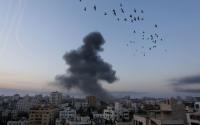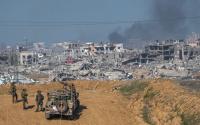By Kim Sengupta10 September 2002
The report by the International Institute for Strategic Studies is being promoted by the hawks in Washington and their supporters in Whitehall as providing "proof" that Saddam Hussein is just months away from launching a nuclear bomb.
That is the way is has been presented in some quarters of the media. But an examination of the report shows that, in fact, Iraq is far weaker in weapons of mass destruction and every other military field than it was in 1991 before the Gulf War. The realistic chances of acquiring, let alone delivering, a nuclear weapon without "substantial" outside help, is years away.
The report, edited by Dr Gary Samore, formerly of the US State Department, was presented yesterday in a dramatic and even alarmist style. "War, sanctions and inspections have reversed and retarded, but not eliminated Iraq's nuclear, biological and chemical weapons and long-range missile capacity, nor removed Baghdad's enduring interest in developing these capacities", said IISS director Dr John Chipman.
"Wait, and the threat will grow. Strike, and the threat may be used."
The report has been described as the most comprehensive yet into Iraq's acquisition of nuclear, chemical and biological weaponry, and their possible means of delivery.
It was compiled in eight weeks, starting in June, based on reports of Unscom, the UN weapons inspectors who had not been in Iraq since 1998, consultations with "experts" on what may have happened since then, and newspaper cuttings.
These are the report's overviews and conclusions.
Nuclear/Radiological
Following the the tripling of oil prices after the 1973 Arab-Israeli war and the increase in oil revenues, Iraq embarked on an ambitious nuclear programme. On 7 July, Israeli warplanes destroyed al-Tuwaitha Nuclear Research Centre near Baghdad, setting back the programme considerably.
The Iraqi programme went underground and, by 1990, had reached a stage when it could produce two nuclear weapons a year, and – had it not been for the Gulf War – " Iraq could have accumulated a nuclear stockpile of a dozen or more weapons by the end of the decade."
However, "Gulf War strikes devastated Iraq's overt and covert nuclear facilities. All of the major facilities ... including all safeguarded research reactors and most laboratories, were damaged or destroyed."
During the years of weapons inspections, until 1998, Iraq sought to hide its nuclear programme by destroying some of the evidence. The "nuclear potential was not completely eliminated ... the scientific and technical expertise of Iraq's nuclear programme survived."
Since 1998, "Baghdad retains a strong interest in developing nuclear weapons but it seems unlikely Iraq has produced, or is close to producing, nuclear weapons from indigenously produced nuclear material."
The "overview" is "Iraq could produce nuclear weapons on a fairly short notice if it was somehow able to acquire sufficient nuclear material from a foreign source but there is no evidence it has done so. " ...Iraq could divert in-country radioisotopes or obtain material from foreign sources for a radiological weapon. But how such a weapon could be delivered, and its effectiveness, remain open to question."
Biological
At the time of the Gulf War, Iraq had filled munitions with biological weapons and deployed them. Individual commanders were given permission to use them if Baghdad was threatened or if there was the threat of a nuclear attack by the Allies. The coalition counties were not aware of this until 1995.
During the years of weapon inspection, Unscom found traces of biological weapons agents on the containers of destroyed al-Hussein missile warheads and R-400 bombs, but could not verify the numbers. There was no verification of Iraqi claims the programme was terminated in 1991.
Since 1998, the report claims "Iraq possesses an industrial capability and knowledge base to produce agents quickly and in volume if desired. Aside from conventional military munitions, delivery of biological weapons by individuals or small groups acting as commandos or terrorists remains a plausible threat that is very difficult to defend against".
But, the report says "Iraqi biological munitions could spread terror and provoke a strong political response but are unlikely to cause mass casualties, unless Iraq has made substantial advances in delivery technology."
Chemical
From 1982 to 1988, Iraq constructed industrial-scale chemical weapons facilities, and stockpiled raw material. "It produced effective (if primitive) chemical munitions in the form of aerial bombs, artillery shells and rockets."
During the Gulf War, Iraq "apparently mobilized its chemical forces, filling al-Hussein missile warheads, R-400 aerial bombs, and other munitions." During the years of inspection, " it is unlikely that Iraq produced substantial new quantities of agents or munitions between 1991 and 1998."
The report's "overview" says "Although Iraq's current chemical capabilities are reduced from their high point in 1990 before the Gulf War, it is probably able to mobilise a limited capability for use in battle against civilian targets."
The report concludes "Iraq's current chemical capability probably comprises hundreds of tonnes of agents ( presumably a mixture of mustard and nerve agent, most likely sarin and cyclosarin) and perhaps a few thousand munitions."
Ballistic missiles
Iraq's al-Hussain missile strike against a US military facility caused the greatest number of US casualties in one incident. The mobility of the launchers meant that no operational missiles were destroyed during the war. During the years of inspection "Unscom made considerable progress in verifying Iraqi declarations of its destruction campaign but questions still remained about a small amount of imported and indigenously produced missiles, warheads, missile propellant, and engine components."
However, Iraq covertly negotiated with 500 companies from 40 countries in an attempt to get missile technology, says the report. It's "small number" of al-Hussain missiles with a 650km range can reach Israel, Saudi Arabia, Kuwait and Turkey. However, the report has no evidence that Baghdad has ever intended to use them. The report concludes "Iraq probably has a small number of missiles. Some worst case scenario puts this number at several dozen missiles; a more likely figure is around a dozen."
IISS has strong establishment links
COMING TWO days before 11 September, and in one of the most critical periods in the debate over a fresh Iraq war, the IISS report could not have been better timed to influence coming events and attract maximum publicity.
Starting in June, the IISS took eight weeks to compile the report, and, says the organisation, it was always due out at this juncture, whatever the state of play with military action.
The methodology appears to have been to rely to a very great extent on the UNScom weapons inspectors' reports, which were produced until 1998; take soundings from various experts and officials on what could have happened subsequently; and a copious perusal of newspaper cuttings.
The report, costing £40 to non IISS members, is edited by Dr Gary Samore, an American who served in the State Department during the Clinton administration. Dr John Chipman, the Institute's director, who presented it yesterday, is a former Nato fellow.
The organisation insists it is independent and does not receive any general government funding, although it does get funding "for the organisation of meetings and for research from government departments". The Foreign Office contributed £100,000 to the setting up of its new headquarters, Arundel House, in central London.
The institute's income, according to the IISS website, comes from "a range of international bodies and foundations", individual and corporate membership, and its publications. There is little doubt that the IISS, set up in 1958 at the height of the Cold War, has strong establishment links. When it moved to Arundel House from Covent Garden, Lady Thatcher and Lord Robertson of Port Ellen, the Nato secretary general, were on the guest list.
The institute spent £8m refitting Arundel House, the former townhouse of the dukes of Norfolk, of which £1m was given by Conrad Black's Hollinger Group, which owns Telegraph newspapers. Further donations came from the Taiwanese Foreign Ministry (£350,000) and the Japanese government (£130,000).
IISS officials point out it has been critical of Western governments. A report on the US role in the Middle East and several other crisis points stated that Washington's leadership was often found wanting. "It is often late into crisis management and oscillates unpredictably between unilateral and multilateral approaches to international problems."






